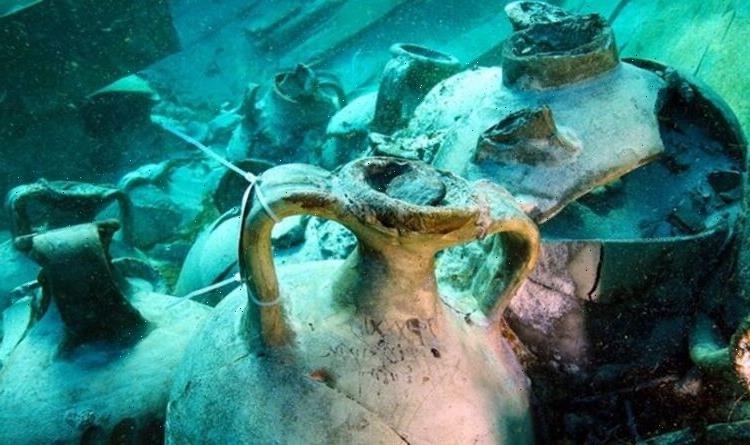Roman settlement's 'decline' discussed by historian
We use your sign-up to provide content in ways you’ve consented to and to improve our understanding of you. This may include adverts from us and 3rd parties based on our understanding. You can unsubscribe at any time. More info
The wreck, dubbed “Ses Fontanelles”, was exposed a mere 165 feet offshore from the popular beach of Ca’n Pastilla in Palma after storms back in the summer of 2019. Experts believe that the vessel from Cartagena was likely anchored just offshore when rough weather caused it to sink — perhaps as a result of running aground on some rocks. Archaeologists from the universities of Barcelona, the Balearic Islands and Cadiz have just finished a three-month effort to painstakingly excavate the vessel’s ancient cargo.
According to the team, the results of the underwater excavation have been “frankly exceptional, since they have made it possible to fully discover the cargo of the ship”.
Ses Fontanelles — which was 39 feet from bow to stern and had a beam of 20 feet — sank, the experts explained, “in the middle of the 4th century AD, in an excellent state of conservation”.
In total, the archaeologists recovered nearly 300 amphorae, tall ceramic jars with twin handles that were used in Roman times to store and transport assorted foodstuffs.
Analysis of traces of the ceramics’ contents indicate that Ses Fontanelles was carrying mixed cargo, including fermented fish sauces, oils, wines and so-called defrutum, a grape syrup used both to preserve and sweeten wine but also as a condiment.


Many of the amphorae were found to still be intact, while around 100 sported inscriptions known as “titulus pictus” that specify the contents, origin and destination of each jar.
In fact, this makes Ses Fontanelles the largest known collection of titulus pictus in Spain and second only globally to the ancient spoil heap of Monte Testaccio in Rome.
Notably, some of the painted inscriptions describe their amphorae’s contents as being “oleum dulcis”, or “soft oil”.
The researchers said: “We know that it was part of a batch put on sale by an ecclesiastical authority — either the bishopric of Cartagena, or some monastery — as can be deduced from the inscription that appeared on the ceramic caps that sealed them, with names and the Chrismon (or monogram of Christ).”
The archaeologists added that they hoped further study of the titulus pictus in the coming months would help them delve further into the details of the merchants that arranged for these wares to be shipped by sea — and whether they acted individually or as part of a mercantile consortium.


Alongside the amphorae, several other “exceptional archaeological pieces” have been found — including a bow drill used by carpenters to repair boats that is one of only a few of its kind to remain preserved anywhere in the world.
The researchers also recovered a cooking pot, an oil lamp, several ropes used on board the vessel, a pair of shoes made from leather and a second pair made from esparto, a type of grass fibre.
Thanks to being rapidly buried in sediments with little oxygen, much of the vessel’s wooden structure also remained well-preserved.
Features noted include a number of cargo-separating bulkheads and the bilge pit at the bottom of the craft’s hull.
DON’T MISS:
Poland ‘under attack’ – fears for Ukraine’s neighbour over Ukraine war [ANALYSIS]
Musk humiliates Putin after Russia threaten to block US from old tech [REPORT]
EU masterplan to CUT Russia’s gas tipped to ‘backfire’ [INSIGHT]

Geophysical surveys taken of the area around Ses Fontanelles at the beginning of the excavation work back in November last year have also helped to reveal a second wreck.
This older vessel — suspected to be Late Punic in age, dating to around 150 BC — was loaded with amphorae of wine that had been dispatched from Ibiza.
The experts are concerned, however, about the future of Ses Fontanelles, lying as it does so very close to the shore and just beneath six-and-a-half feet of water, leaving it vulnerable to extreme weather and also looting.
The archaeologists add that the wreck is at “risk of potential destruction if the storms that led to its discovery occur again.”
Given this, the Majorcan authorities are presently exploring whether the hull of the boat, rather than just its cargo, might also be safely extracted from the seafloor and preserved for posterity in a museum setting.
The excavations of Ses Fontanelles are part of a wider, three-year project dubbed “Arqueomallornauta” which aims to explore maritime traffic in Majorca in Late Antiquity.
Source: Read Full Article
